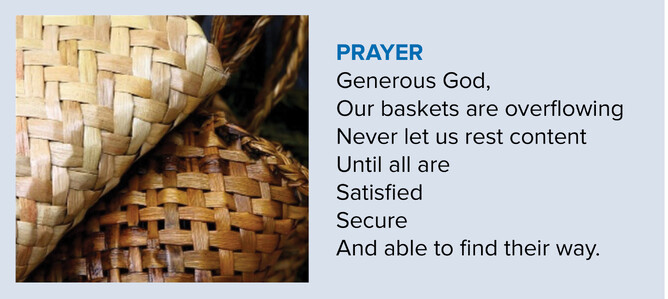Nau tō rourou, naku te rourou, ka ora te manuhiri
With your basket and my basket, the people will thrive.
The picture above portrays an event in the life of St Martin of Tours. The story goes that Martin, while still preparing for baptism, came across a beggar, freezing from lack of clothing in the middle of winter. Martin then removed his cloak, cut it in half with his sword and presented one half to the man. Later that night, Martin had a vision of Christ saying: “Martin, a mere catechumen has clothed me”.
The artist, Fr David Orange. He views this work as a visual reminder of our call to live justly. We might ask, why did Martin not give away the whole cloak? To that we could reply, “what would be the point? No doubt Martin was also cold. There would be little point in him freezing to death as well. So, by splitting his cloak in half he would save both himself and the beggar”. The whakataukī above simply asks for what you can give from your basket.
There does not appear to be in Scripture anything that commands Christ’s followers to give away half, unless they want to go all the way, then they give away everything! However, there is plenty to show that salvation doesn’t come without compassion for those in need and the soul is dead when we ignore the cry of the poor, e.g. the Dives and Lazarus story (Lk 16:19-31). In the story, when the rich man cries out to Abraham to send a little water to cool his tongue, Abraham points out that there is a great gulf separating them, and even if either side wanted to, they would not be able to cross it. What is being implied here, is that a priority in our lives for the poor has to be something we practice quite naturally. It isn’t something we will take up after a life time of accumulating wealth. Our hearts will have become so hardened that even a token gesture will be impossible.
Now what is true in this regard of an individual, is true also of society as a whole. When we examine our wealth closely, we need to be constantly asking whether or not, at least corporately speaking, we are becoming like the rich man and our hearts are hardened as a result.
A half and half mentality would certainly solve our problems in regard to poverty and each side would have plenty. However, it is simply a matter of giving away what we don’t really need. In some cases, this may well be half, or even more, but generally speaking, all we are asked to do is to willingly share. Then, as the whakataukī above implies, the people will thrive.
The story of St Martin cutting his cloak in half is certainly a moving one. We can presume it was made of very practical material for the climate, enough to wrap around himself and more. He gave from his basket. But would not the beggar also have needed food? Perhaps it were another kind soul who came along and gave that beggar food. Then, would he not have needed shelter? Martin had given what he could. Without food and shelter however, the story is incomplete, which only proves that what is needed must come not just from my basket, but yours as well. And when we think about it that is exactly the underlying method of operating for the Society of St Vincent de Paul. It depends all the time on something from my basket and something from yours.
Discussion:
Would you think the whakataukī above would make a good logo for the Society’s work?
Do you think the Society’s present form of operating is good enough for what is needed in Aotearoa/New Zealand?
Do New Zealanders generally speaking live by the saying: From my basket etc. Or have our hearts become hardened like the rich man in the gospel?
Note: Readers may be interested to know that St Martin of Tours is the patron saint of the Pungarehu parish in coastal Taranaki. Some 50 years ago, the then parish priest, Fr Barney Keegan, commissioned well known artist, Fr David Orange to create this picture at the entrance of the church, so that it would greet parishioners as they arrive at Mass each Sunday. The work is known as Scarfito (scratching). Using a trowel the picture was formed from three layers of plaster.




